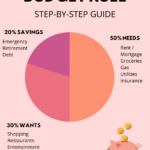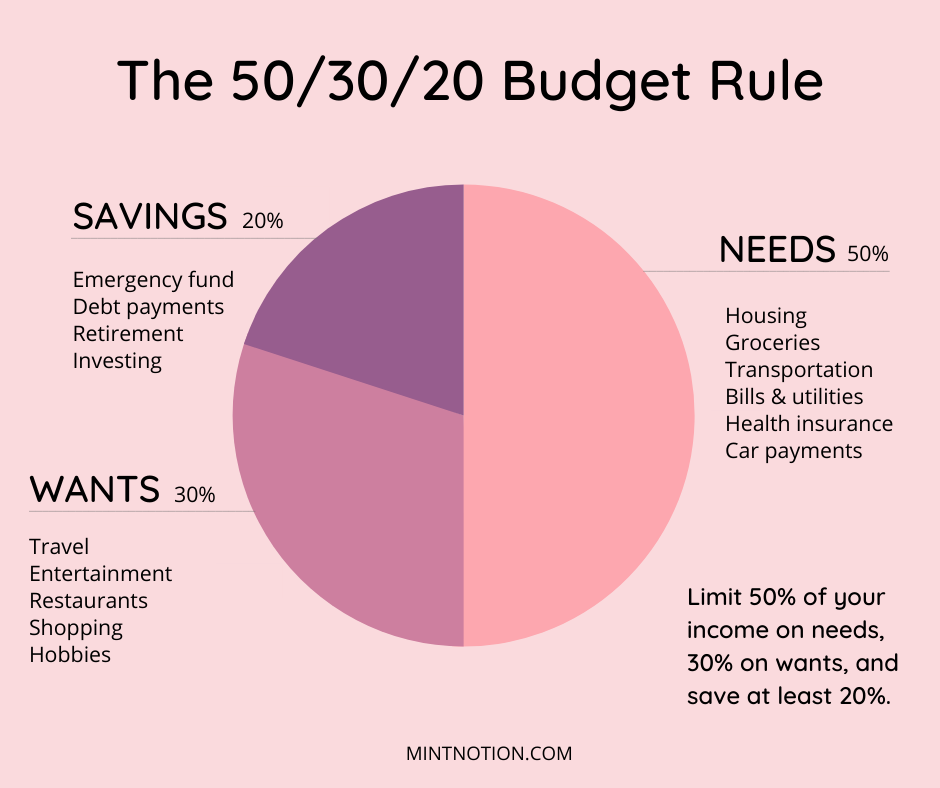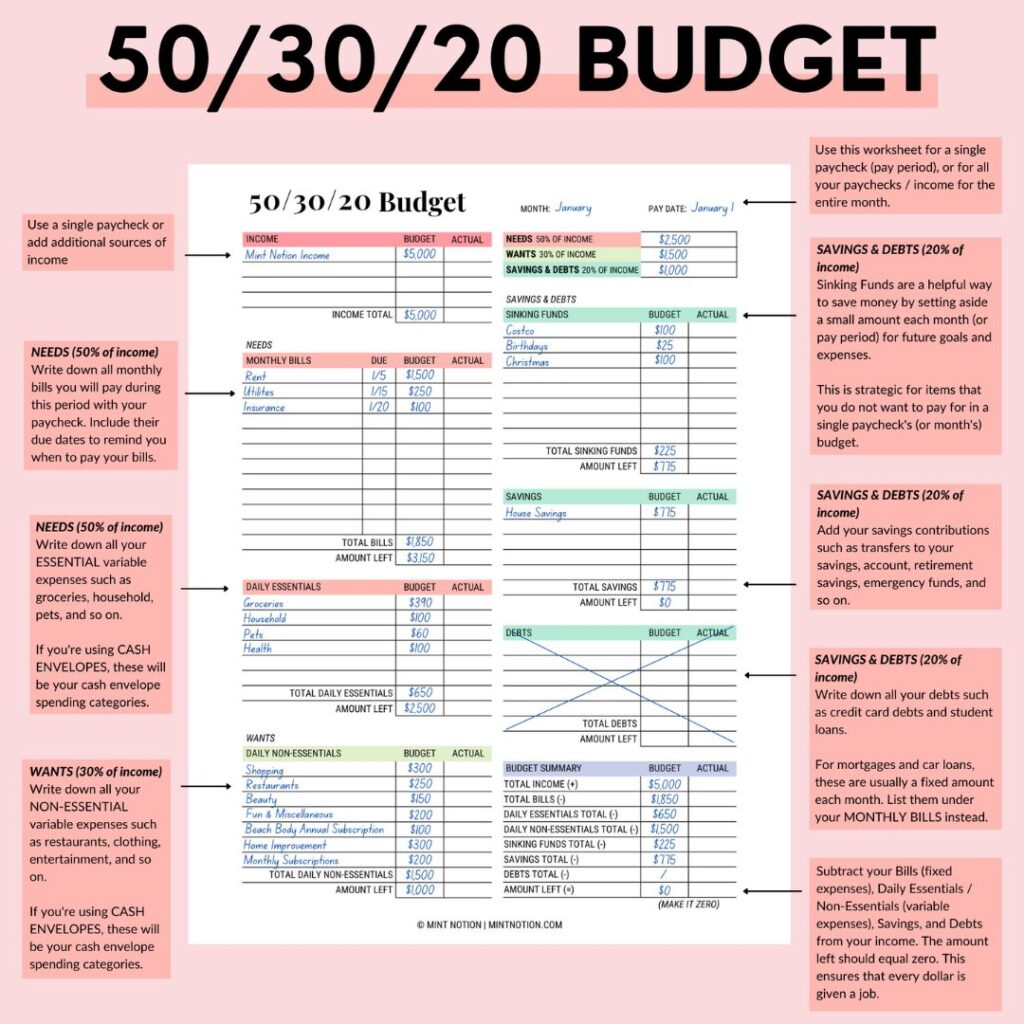The 50-30-20 rule is a simple way to budget your money, especially for those who are new to budgeting or dislike the idea of tracking every individual expense. 50% of your monthly take-home income goes towards your needs, 30% goes towards your wants, and the remaining 20% goes towards your savings.
It only requires you to track and divide your monthly expenses into three main spending categories: Needs, Wants, and Savings.
If the thought of budgeting sounds intimidating, you may want to consider giving the 50-30-20 budget rule a try. This budgeting strategy is perfect for beginners.
Let’s find out how it works and how you can create a realistic budget that’s easy to stick to!
Table of Contents
What is the 50/30/20 budget rule?
The 50/30/20 budgeting rule was popularized by Senator Elizabeth Warren in her book, All Your Worth: The Ultimate Lifetime Money Plan.
It’s a simple way to budget your money by dividing your spending into three separate categories: 50% for your needs, 30% for your wants, and 20% for your savings.
Related Posts:
- What is a zero-based budget?
- How to start using the half-payment method to budget
- How to budget when you get paid biweekly
What are the three categories included in the 50-30-20 budget?
50% of your after-tax income should go towards your needs.
This includes housing expenses (rent or mortgage), groceries, transportation, basic utilities, insurance, child care, and minimum debt payments.
30% of your after-tax income should go towards your wants.
This includes vacations, restaurants, concerts, movies, entertainment, shopping, monthly subscriptions, and luxury products.
20% of your after-tax income should go towards your savings.
This includes cash savings, debt payments such as student loans, emergency fund, retirement, investments, and other savings goals.
This budgeting rule was created to help individuals manage their money so they can save for emergencies and retirement. Many people like following the 50-30-20 rule because it’s simple.
You don’t need complex spreadsheets or tools. You can easily break down your budget (using percentages) by writing your spending down on paper.
If you’re new to budgeting, the 50-30-20 rule can be a great starting point because it offers lots of flexibility. It also simplifies your spending because everything is broken down into just three categories.
How do you calculate percent of budget?
Many people ask, “how much should I be spending a month?”. Let’s say your monthly take-home pay is $3,000.
You can use a budget calculator to break this down into your three main budget categories.
Below is an example of the 50-30-20 rule of thumb:
- Needs $1,500 (50%) – To calculate how much to budget for your needs, you would multiple $3,000 x 0.50= $1,500.
- Wants $900 (30%) – To calculate how much to budget for your wants, you would multiple $3,000 x 0.30 = $900.
- Savings $600 (20%) – To calculate how much to budget for your savings, you would multiple $3,000 x 0.20 = $600.
How much of your income should go to bills?
According to the 50-30-20 budget rule, 50% of your monthly take-home income should go towards your needs.
This includes in your necessary bills that pay for your shelter, food, and transportation.
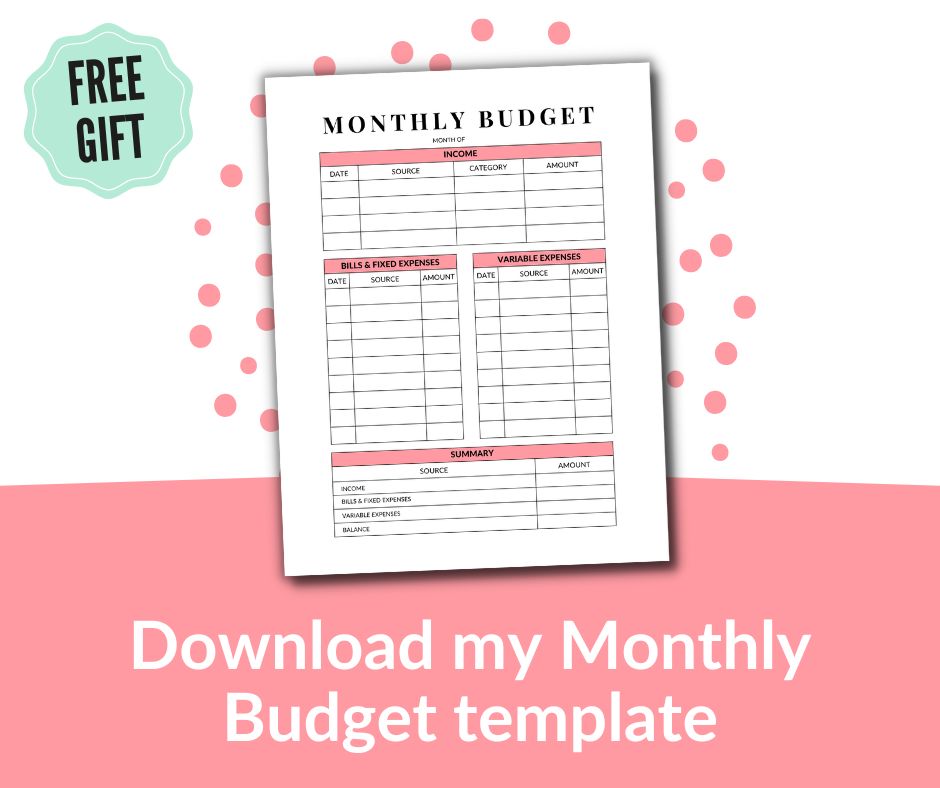
How to budget with the 50-30-20 rule
To get started in following the 50-30-20 rule, here’s an easy step-by-step guide.
You can use a pen a paper to do this or grab my 50/30/20 budget template here. It’s includeded in my Budget Planner – the complete budgeting resource I use to organize my finances.
Remember, this budgeting strategy is flexible. You can adjust the percentages based on your lifestyle and goals. For example, if you want to focus on paying off debt, you can change the ratio to 50/20/30.
Or if you live in area with a high cost of living, you can adjust the ratio to 60/20/20 to better suit your needs.
Read Next: What is the 70-20-10 buget rule?
Step 1: Calculate your after-tax income
The first step is to calculate your monthly take-home pay. This is your after-tax income, also known as your net-income, rather than your gross income.
To calculate your take-home income, subtract any taxes and pretax payroll deductions from your gross income.
If you’re using my 50/30/20 budget template, you’ll write down your income under the “Income” section.
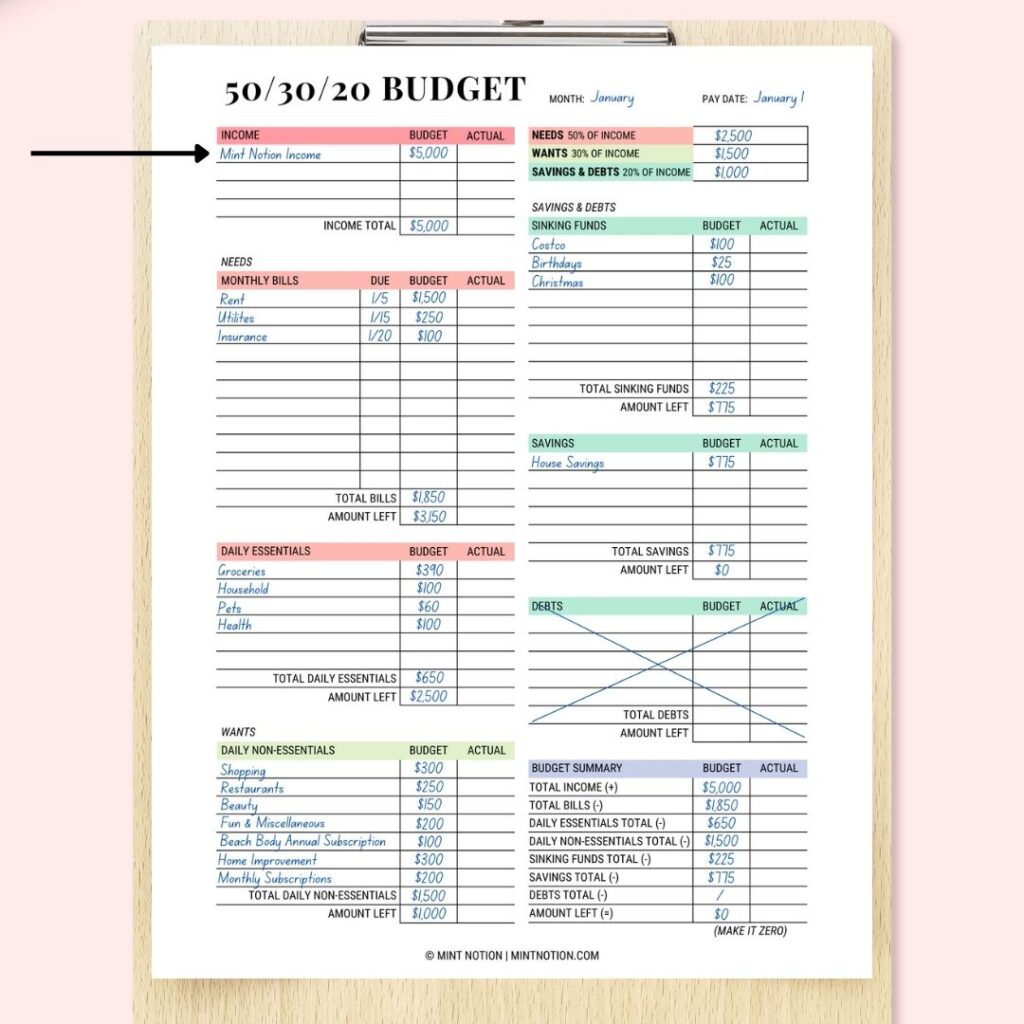
If you’re an employee with a steady paycheck, this amount will appear on your paystubs. If your employer deducts retirement contributions, health insurance fees, or automatic savings, add those back in.
If you’re self-employed, this is your gross income minus your business expenses and the amount you set aside for taxes.
If you’re budgeting together with a partner, you can add your after-tax income together to make a budget for your household.
Once you’ve calculated your monthly take-home pay, you can divide your income between three spending categories: Needs (50%), Wants (30%), and Savings (20%).
Step 2: Limit your needs to 50% of your income
The next step is to figure out how much money you currently spend on your needs. These are your essential living costs and bills that you must absolutely pay each month.
Think your rent or mortgage, groceries, car payments, insurance, health care, minimum debt payments, and utilities.
If you’re using my 50/30/20 budget temple, start off by writing down your bills under the “Monthly Bills” section. Then write down your essential living costs under the “Daily Essentials” section.
Being able to differentiate between your “needs” and “wants” can be tricky. For example, you need to drink water to stay hydrated, but buying pop and expensive bottles of water is a “want”.
You’ll have to use your own discretion when it comes to separating your needs and wants. Ideally, your needs should only include things that you can’t live without.
You want to aim to spend 50% of your monthly after-tax income on your needs. These are necessary expenses that you can’t avoid, otherwise it can severely impact the quality of your life.
If you’re paying off credit card debt, you can’t forgo the minimum payment on your credit card because your credit score will be negatively impacted if you don’t pay the minimum.
That’s why minimum payments are considered a “need”.
Read Next: 50 creative ways to save money on a tight budget
Step 3: Limit you wants to 30% of your income
The next step is to figure out how much money you currently spend on your wants. These are extras that aren’t essential to living or working.
If you’re using my 50/30/20 budget template, write down these items under the “Daily Non-Essentials” section.
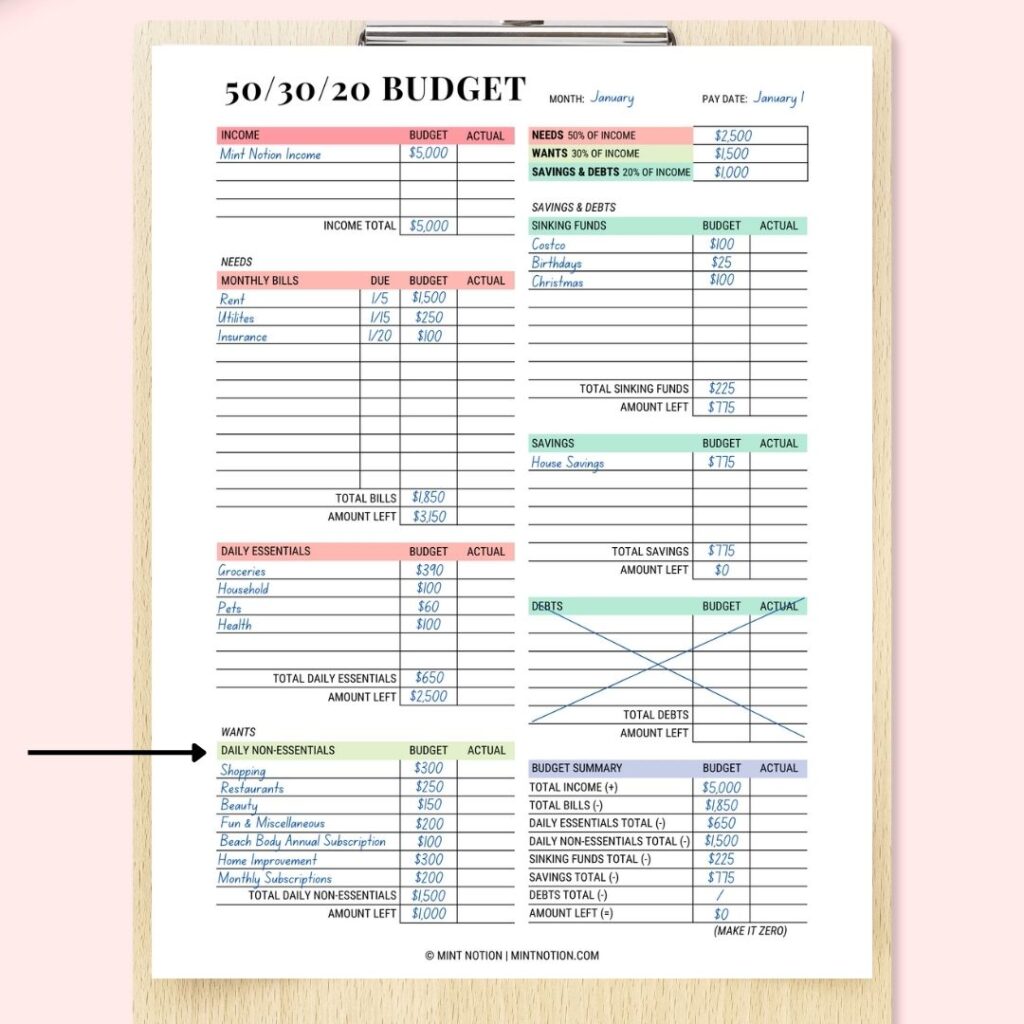
This is the one spending category that can make the biggest difference in your budget, especially if you’re trying to quickly save money or pay off debt.
While spending 30% of your income on your want might sound generous, these expenses can easily add up. You may even realize that you’re currently spending more on your wants than you think.
These are your non-essential living costs, such as an upgraded cell phone plan, coffee at Starbucks, Netflix subscription, travel, hobbies, shopping, entertainment, restaurants, gym memberships, gifts, and so on.
This will look different for each person, depending on your lifestyle and what you’re willing to sacrifice. These expenses are usually variable from month to month.
For example, one month may involve higher spending on gifts and another month higher for entertainment. The key is to limit 30% of your take-home pay on wants.
Step 4: Spend 20% of your income on savings and debt payments
The final step is to allocate at least 20% of your income to savings, debt payments and investments.
If you’re using my 50/30/20 budget template, start by writing down the sinking funds you’d like to save for under the “Sinking Funds” secton.
Then write down your savings under the “Savings” sections and debts under the “Debts” section.
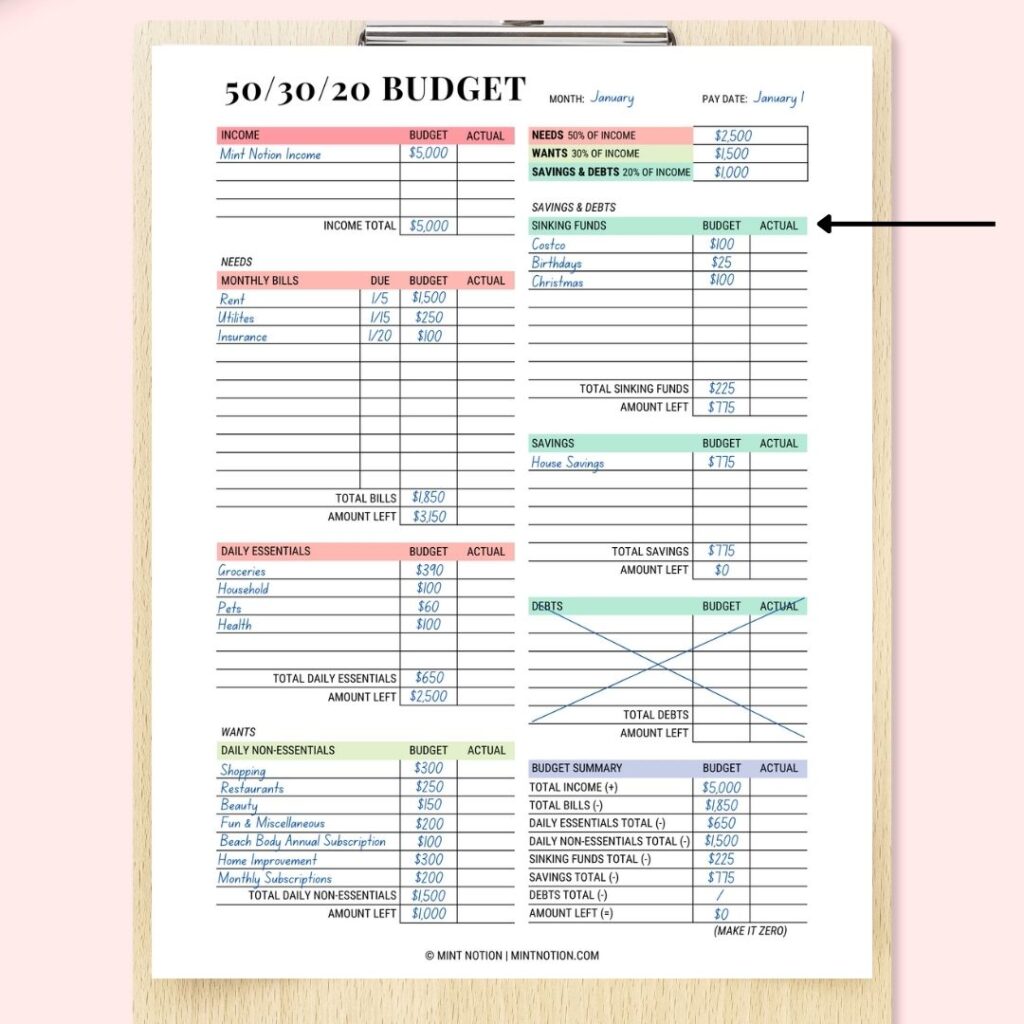
Minimum payments on your debts are considered “needs” and are counted toward the 50%.
Any extra payments to reduce your debts will be classified as “savings” and goes under the 20% heading.
You’ll want to have at least three-to-six months’ worth of living expenses in your emergency fund.
If you don’t have an emergency fund in your cash savings right now, a good place to start is by saving $1,000. This can help you be prepared to cover any unplanned costs without having to go into debt.
Once you’ve built your emergency fund, you can use this 20% to throw extra money towards paying off debt.
Aim to pay off your debt with the highest-interest first, as this will save you the most money. This is known as the debt avalanche method.
Once you’ve paid off your debt (not including your mortgage), you’ll want to use this 20% category to put more money towards your savings and investments.
Below are some more examples of savings and debt repayments included under the 20% area of your budget.
Short-Term Savings & Debts
- Paying off credit card debt (above the minimum payment)
- Building your emergency fund
- Saving to make home improvements
- Saving for a wedding / honeymoon
- Saving to buy a car
- Saving for a house down payment
Long-Term Savings
- Saving to pay off your mortgage
- Saving for retirement (beyond what’s already deducted from your gross income)
- Saving for your children’s education (such as through a 529 plan)
- Saving to start a business
Read Next: What’s the best way to pay off debt?
Step 5: Make adjustment and stick to it!
No matter which budgeting method you choose to follow, the key is to actually stick to it.
Start by separating your money into the three budget categories as soon as you get paid. Put 50% towards paying your needs, 30% towards your wants, and 20% towards your savings.
PRO TIP: Schedul a budget date with yourself once a week. Treat it as a self-care activity for you, your finances, and your goals.
I like to put this Budgeting for Success playlist on and let it inspire me as I check-in with my budget to see where I’m doing well and where I can make improvements.
This also gives me time to make adjustments to my budget throughout the month as needed.
50/30/20 budget example
Here’s a simple example of the 50/30/20 budgeting rule. Let’s say you earn $3,000 per month (take-home pay).
This means you’ll divide your income in three spending categories:
- 50% towards need = $1,500
- 30% towards wants = $900
- 20% towards savings = $600
This means that you probably don’t want to spend $1,000+ per month on rent or a mortgage payment, especially if you need to pay for other “needs”, such as car payments, insurance, cell phone, groceries, and utilities.
Depending on your lifestyle and where you live, you may find that your needs will exceed 50% of your income.
If so, it’s fine to make adjustments by shifting some of the cash from your wants to cover your needs.
But ultimately, you’ll want to aim to reduce your needs so it can fit comfortable into the 50% category.
Is the 50/30/20 budget rule good?
The 50/30/20 budget can be great for those who don’t like the idea of budgeting, because you only have to break down your spending into three categories: Needs, Wants, and Savings.
Pros of the 50/30/20 budget
It works best for those who are making an average income and prefer to just focus on three budget categories.
This can help you organize and track your finances without having to worry about categorizing every individual expense.
It’s a simple and effective option for those who are new to budgeting and want to start saving more money.
Following the 50/30/20 budget rule is better than having no plan for your money. A recent poll found that only one-third of Americans maintain a household budget.
Following an easy budgeting method, such as the 50/30/20 rule can be great starting point to organize your finances.
Cons of the 50/30/20/budget
On the other hand, the minimal budget structure can make it difficult to find ways to improve your spending habits, especially if you have trouble differentiating between “needs” and “wants”.
If you are living on a reduced income, your budget may not fit these categories because your needs and wants will take up more of your take-home pay.
For young professionals or those who live in an expensive area, they may not be able to follow this budgeting rule because it’s not realistic for their current income level.
If you’re a high-income earner, this budgeting system may not work for you either. This is because you probably want to put more money towards your savings and investments, instead of spending the majority on your needs and wants.
A budget should evolve over time, based on your lifestyle, income and financial goals.
For example, some people try to throw all their extra money towards paying off debt while cutting their living expenses are much as possible.
Or for someone who wants to save up to buy a home or a car, 20% of their take-home income might seem too small. In this case, they’ll choose to limit their needs and wants and increase their monthly savings contributions.
How to make a budget for beginners (Step-by-Step Video)
If you need more guidance, check out this video where you’ll learn how to make a budget for beginners.
Other popular budgeting methods to consider:
Keep in mind that the 50/30/20 budget isn’t the only option. Other popular methods which I love include:
Zero-based budget
This is how I like to budget and organize my finances. This budgeting method means your income minus expenses will equal zero.
With a zero-based budget, every dollar you have is assigned a job. Some of your dollars will be assigned to paying expenses, some of them will go towards your savings, investments, or paying off debt.
Read Next: What is zero-based budgeting?
Envelope budget system
The cash envelope system was made popular by Dave Ramsey. It’s a budgeting method where you use cash and envelopes to help track and manage your monthly variable (or discretionary) spending.
You can also use the envelope budgeting system without cash, which can be just as effective. This can be a great option for those who want to learn how to budget when living paycheck to paycheck.

You can grab my free cashless envelopes here to get started. Then check out this in-depth tutorial on how to use the cash envelope method without cash.
Budget calendar method
A budget calendar looks just like a regular calendar, but it’s used for the purpose of tracking your bills, due dates, paychecks, and other important dates in your life.
It’s a helpful way to get an overview of how much money will flow in and in in a given month.
Here’s a few things that you may want to include in your budget calendar: Paydays, bills and their due dates, savings contributions, and special events or holidays.
Read Next: What is a budget calendar and how to use it successfully
70/20/10 Rule Money
What is the 70-20-10 rule money? It’s similiar to the 50/30/20 budget rule.
- 70% of your monthly budget should go to monthly expenses (living expenses)
- 20% should go to savings and debts
- 10% should go to investments and donations
Read Next: How to follow the 70-20-10 budget rule for beginners
60/30/10 Rule Budget
Again, this is similiar to the 50/30/20 budget rule. Sometimes it’s known as the 60/20/20 budget rule.
- 60% of your monthly income should go to essentials and living expenses. This includes rent / mortgage, groceries, and transportation.
- 30% of your income should go to financial goals. This includes emergency fund, investments, and debt payments.
- 10% of your income should go to discretionary spending. This includes travel, eating out and entertainment.
30-30-30-10 Budget
This is another easy way to divide your monthly income among different spending categories in your budget.
- 30% of your monthly income should go to our housing needs. This includes rent / mortgage, appliances, transportation and so on.
- 30% of your monthly income should go to other living expenses. This includes utility bills, groceries, clothing, internet, phone, and school needs.
- 30% of your monthly income should go to your financial goals. This includes paying off debt, saving for retirement, investing, and other saving goals.
- 10% of your monthly income should go to your wants (discretionary spending). This includes entertainment, eating out, streaming services, and travel.
50/30/20 Budget Rule FAQs
Can you follow the 50/30/20 budget rule with irregular income?
Yes! The 50/30/20 budget rule can work even if you have irregular income. This means you get paid different amounts and / or at different times on a regular basis.
I run my own online business and earn irregular income too. It’s just as easy to create a 50/30/20 budget with irregular income as it is with regular income. It just looks a little different.
You’ll base your budget on your lowest earning month for the past year. Next, you’ll divide this amount into three categories: 50% needs, 30% wants, and 20% savings.
Aim to pay your monthly bills and living essentials first (rent / mortgage, utilities, transportation, and food). Then you can set aside money for your savings and debt payments. Any leftover money can go towards your wants.
Read Next: How to budget with an irregular income
Is the 50/30/20 rule weekly or monthly?
The 50/30/20 rule splits your monthly income into three categories: needs, wants, and savings. However, if you get paid biweekly, you can create a new budget for each paycheck and follow the 50/30/20 rule.
What is a good amount of money to have leftover after bills?
If you’re following the 50/30/20 budget rule, you should have 50% of your income leftover after paying your bills. This is assuming that your bills (needs) total half your take-home monthly income. Then you can use the leftover money to cover your wants and put towards your savings.
How much per paycheck should you save?
If you’re following the 50/30/20 rule, you should save at least 20% of your paycheck. This can go towards your saving goals, investments, or paying off debt.
Why is the 50/30/20 rule easy for people to follow, especially those who are new to budgeting and saving
The 50/30/20 rule is easy to follow because it’s flexible and simplifies the process of budgeting by allocating your money among needs, wants, and savings.

